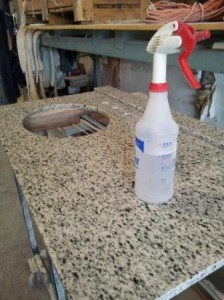
Granite being sealed during fabrication at Precision Stoneworks
“Should I seal my granite and marble, and how often?†is a question we are frequently asked. Homeowners want to know if sealing granite and marble is necessary, and if it will prevent any and all stains.
The best answer is perhaps a qualified, “It depends.†Generally speaking darker granites like Ubatuba and Tropic Brown do not need sealing very often, and once per year is usually sufficient. Dark stones are denser than lighter ones, and any stains are usually nearly invisible or barely perceptible because of the darkness of the stone. In plain terms the lighter the color, the more often you should seal it. White and light-colored granites should be sealed more often. Most recommendations would say every three months.
Marble, especially light colored marble, should be sealed more often as an extra precaution. Re-sealing marble every 3-6 months is a good idea.
While it may seem like quite a project, sealing countertops is a very easy process and that homeowners should not be afraid of. It should only take just minutes and there usually little to no elbow grease involved.
Good quality sealing products can be purchased at any home improvement retailer and a small, inexpensive bottle will last many sealing applications. The peace of mind provided by sealing easily outweighs the minimal expense and short time required.
Sealing granite or marble is easy:
- Clear everything off the counters so the entire surface is accessible.
- Clean the surface with a mild detergent (dish soap is fine).
- If needed, scrape away any built up residues that may have accumulated since the last time the surface was thoroughly cleaned. A single edged razor blade or scraper can be helpful, but be careful not to gouge the blade into the countertop or your finger!
- If needed, acetone can help remove residues from things like window cleaners and will help strip even the old sealer off.
- Follow the directions on the container to apply the sealer. Most often it’s just a matter misting the sealer on, letting it soak in, and wiping away the excess. Sealing a typical kitchen usually requires less than 20 minutes, and vanities often even less. Applying a second coat may provide a greater sense of security, but is not always helpful or necessary since most stones will stop accepting sealer at some point.
- Congratulations! Your stone is protected and you’re now done for months to come!
Between sealing treatments one of the real keys to preventing stains is to clean up any spills as quickly as possible before liquids even have a chance to penetrate the surface.
Tip: In our experience, stains caused by candle wax are the toughest to get out. The dyes that make a candle a certain color tend to stain anything they come into contact with very easily, and the very hot wax penetrates much more readily. It’s a good idea to keep plates or saucers under even unlit candles, as with enough time even unlit candles can stain a light colored countertop.
Watch for future article at precisionstoneworks.com for tips on getting out more troubling stains!

Blog Comments
How to Clean Your Granite | Precision Stoneworks
May 16, 2014 at 11:36 AM
[…] make sure your granite is sealed. Depending on the type of granite you have, it may need to be sealed as often as every three months […]
Donna Rudl
May 30, 2018 at 8:05 AM
Can I use Granite Gold Sealer on marble?